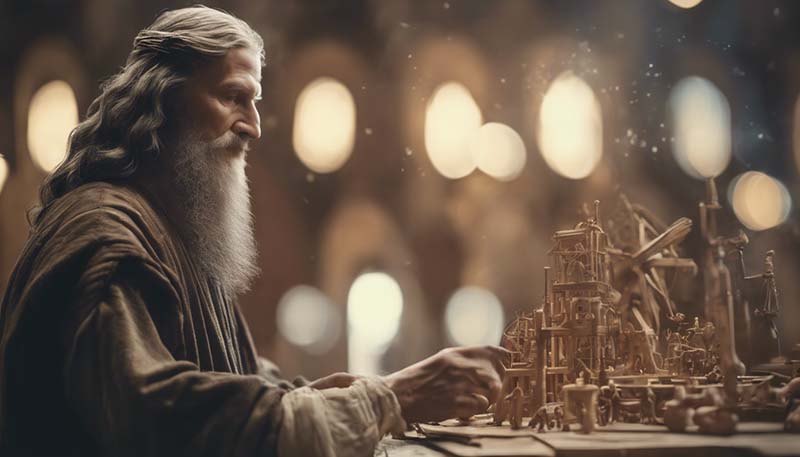Leonardo da Vinci: Renaissance Man and Inventor Extraordinaire
Leonardo da Vinci: Renaissance Man and Inventor Extraordinaire
Leonardo da Vinci (1452–1519) was a true polymath who epitomized the Renaissance ideal of the 'universal genius.' His areas of expertise spanned a vast array of disciplines, including painting, sculpture, architecture, anatomy, music, mathematics, engineering, and astronomy. Despite his diverse interests, Leonardo is perhaps best known for his art, with works such as 'The Last Supper' and the 'Mona Lisa' achieving iconic status. However, his contributions to science and invention are equally significant and continue to inspire scholars and enthusiasts alike.
Introduction: The Life of a Renaissance Man
Born in Vinci, Italy, Leonardo was the illegitimate son of a notary named Piero and a peasant woman named Caterina. His early life was marked by a curiosity that would come to define his approach to the world. Leonardo's talent was evident from a young age, leading to his apprenticeship under the renowned artist Andrea del Verrocchio in Florence. Here, he immersed himself in the intellectual and artistic ferment of the city, laying the groundwork for a career that would see him influence the course of history.
Advertisement
Early Years: Apprenticeship and Education
Leonardo's early years were spent in Florence, where he was exposed to the works of great artists like Donatello and Masaccio. His apprenticeship under Verrocchio was rigorous, covering not only painting and sculpture but also mechanical arts. This period was crucial in shaping Leonardo's artistic style and his approach to the world, which was characterized by a relentless pursuit of knowledge and a deep respect for the natural world.
Artistic Achievements: Masterpieces and Techniques
Leonardo's artistic legacy is profound. His use of sfumato, a technique that involves the subtle blending of tones and colors to create a smoky, atmospheric effect, was revolutionary. His depiction of human emotion and the play of light on the human form is unparalleled. His 'Vitruvian Man,' a study of human proportions based on the works of the ancient Roman architect Vitruvius, is a testament to his interest in the intersection of art and science.
The Last Supper
One of Leonardo's most famous works, 'The Last Supper,' is a mural painting that depicts the final meal Jesus shared with his disciples before his crucifixion. The composition, with its dynamic gestures and expressions, conveys a sense of drama and emotion that is unparalleled in the history of art.
Mona Lisa
The 'Mona Lisa,' perhaps the most famous painting in the world, is a portrait of a woman whose enigmatic smile has captivated viewers for centuries. Leonardo's mastery of sfumato and his innovative approach to portraiture are evident in this work, which has been the subject of countless analyses and interpretations.
Scientific Contributions: Anatomy, Engineering, and Inventions
Leonardo's scientific studies were as impressive as his artistic achievements. His notebooks, filled with detailed observations and sketches, reveal a mind that was constantly exploring and questioning. His anatomical drawings, for example, were centuries ahead of their time, providing insights into the human body that were not matched until the modern era.
Anatomy
Leonardo's dissections and studies of the human body were meticulous and detailed. He sought to understand the mechanics of movement and the structure of bones, muscles, and organs. His anatomical drawings are not only scientifically accurate but also beautifully rendered, reflecting his unique ability to combine art and science.
Engineering and Inventions
Leonardo's notebooks are filled with designs for machines and inventions that were far ahead of his time. He sketched plans for flying machines, including a precursor to the modern airplane, as well as designs for armored vehicles, hydraulic pumps, and various military devices. His inventions, though not built during his lifetime, demonstrate a deep understanding of engineering principles and a visionary approach to problem-solving.
Legacy and Influence: The Impact of a Genius
Leonardo da Vinci's legacy is one of innovation, curiosity, and a relentless pursuit of knowledge. His works continue to inspire artists, scientists, and thinkers around the world. His approach to learning, characterized by a blend of observation, experimentation, and creativity, remains a model for interdisciplinary study and collaboration.

Today, Leonardo's contributions to art and science are celebrated in museums, galleries, and scholarly works. His life and work serve as a reminder of the power of the human mind to explore, create, and innovate. As we continue to uncover the secrets of his notebooks and the depths of his genius, we are reminded that the spirit of inquiry and the joy of discovery are at the heart of human progress.
Conclusion: The Eternal Quest for Knowledge
Leonardo da Vinci's life and work stand as a testament to the potential of human creativity and intellect. His insatiable curiosity and boundless imagination continue to inspire us to push the boundaries of what is possible. As we reflect on his contributions to art, science, and the human endeavor, we are reminded that the quest for knowledge is an eternal journey that enriches our lives and the world around us.
References:
- Clark, K. (1988). Leonardo da Vinci. Penguin Books.
- Clayton, M. (2013). Leonardo da Vinci: The Anatomy of the Horse. Scala Arts & Heritage Publishers Ltd.
- Vasari, G. (1550). Le vite dei più eccellenti pittori, scultori e architetti. Giunti.